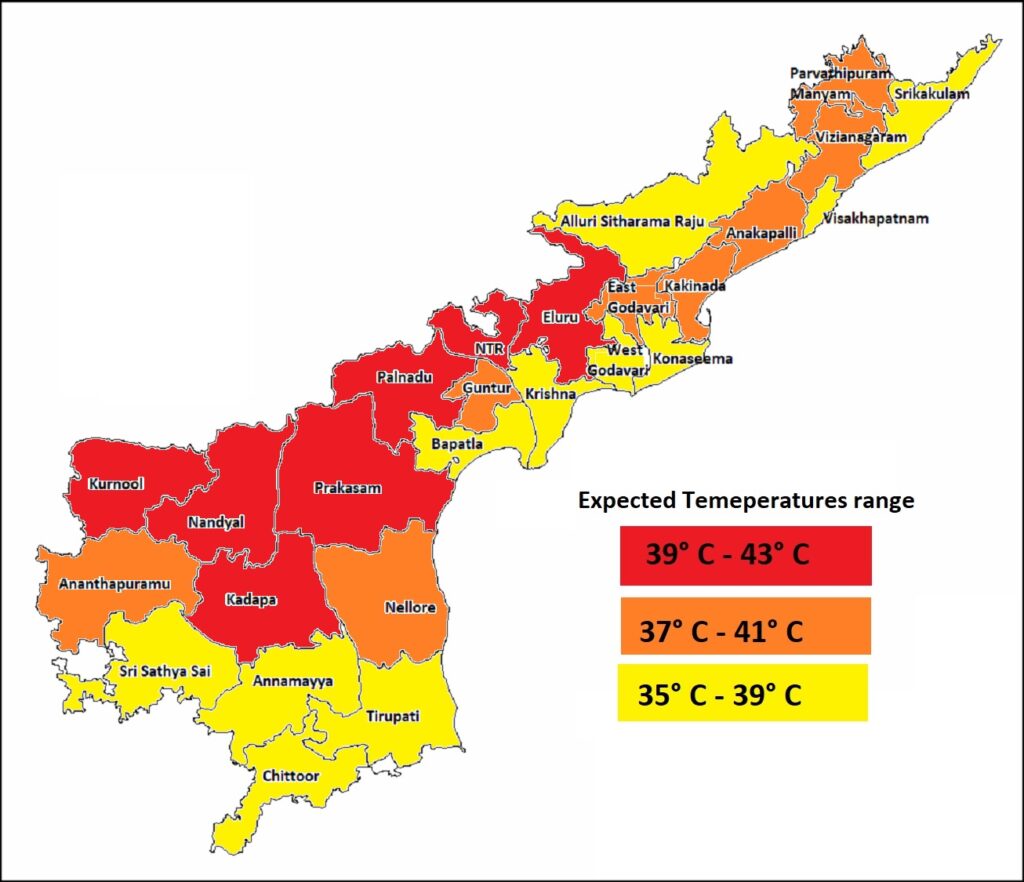As summer intensifies, Andhra Pradesh is set to experience a severe heatwave from March 13 to March 18, with temperatures soaring across multiple districts. The intense heat is caused by a combination of dry winds, clear skies, and prolonged sunlight exposure, which contribute to rapid heating of land surfaces and higher daytime temperatures.

Expected Temperature Ranges (District-wise)
Extreme Heatwave (39°C – 43°C)
🔹 Affected Districts: Kurnool, Nandyal, Kadapa, Prakasam, Palnadu, NTR, Eluru
🔹 Forecast: These regions will experience scorching heat, with temperatures expected to reach 43°C in some areas. Due to low humidity levels, heat retention in the atmosphere will be minimal, leading to extremely hot afternoons and relatively cooler nights. Dry winds from the interior regions will further exacerbate heat conditions.
☀️ Moderate Heatwave (37°C – 41°C)
🔹 Affected Districts: Guntur, East Godavari, Kakinada, Anakapalle, Parvathipuram, Nellore, Vizianagaram, Anantapur
🔹 Forecast: These districts will see temperatures ranging between 37°C and 41°C, creating hot and dry conditions. The presence of coastal influence in some areas may provide slight relief in the evenings, but daytime temperatures will remain high. A moderate hot air flow from the inland regions will add to the rising heat levels.
🌡️ Warm to Hot Conditions (35°C – 39°C)
🔹 Affected Districts: All remaining districts of Andhra Pradesh
🔹 Forecast: These areas will experience above-average temperatures, though not classified as a severe heatwave. The rise in temperature will still create discomfort, particularly in urban areas where heat island effects can make conditions feel warmer than recorded.
🌞 Factors Contributing to the Heatwave
Lack of Pre-Monsoon Showers – Andhra Pradesh typically receives some pre-monsoon thunderstorms, but this year, the region has seen dry conditions, allowing heat to build up.
Strong Dry Winds – Winds blowing from the interior Deccan Plateau and northern regions bring in dry air, reducing moisture levels and increasing heat intensity.
Clear Skies and Prolonged Sunlight – With minimal cloud cover, solar radiation directly heats the ground, leading to extreme daytime temperatures.
Urban Heat Island Effect – In cities, concrete structures, asphalt roads, and limited greenery trap heat, making temperatures feel even higher than recorded.
📉 Possible Impacts of the Heatwave
🌾 Agriculture: High temperatures may impact standing crops, especially paddy, groundnut, and horticultural produce. Farmers should ensure adequate irrigation and shade for crops to minimize damage.
⚡ Power Demand Surge: Rising temperatures will lead to increased electricity consumption, especially for cooling appliances like air conditioners and fans. This may put pressure on the power grid, leading to possible power outages in some areas.
💧 Water Scarcity Risks: Prolonged heat can accelerate water evaporation from reservoirs, leading to lower groundwater levels. Residents may face temporary shortages in water supply if the situation persists.
🔥 Forest Fire Risk: Dry conditions combined with rising temperatures increase the risk of forest fires, particularly in hilly and wooded regions of Andhra Pradesh.
🌡️ Outlook for the Coming Days
Meteorologists predict that heatwave conditions may persist until March 18, with a gradual decline in temperatures expected after that. However, if wind patterns do not shift or pre-monsoon showers fail to develop, the heatwave could extend for a few more days beyond the forecast period.
The state government and weather agencies are closely monitoring the situation, and any further updates will be provided as conditions evolve.
Stay tuned for more updates on the heatwave and its developments. 🌞🔥